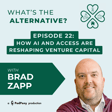
What's the Alternative? | Episode 4 | Diversification with Liquid Alternatives featuring Bill DeRoche
Welcome to Banrion Capital Management’s What’s the Alternative Podcast! Join host Shana Orczyk Sissel, the “Queen of Alternatives” Founder & CEO of Banrion Capital Management, as she interviews leaders in the alternative investment space. Learn more about their firms, their passions and about the many different ways investors can use alternative investments to add value in their investment portfolios.
In this episode "Diversification with Liquid Alternatives" Shana is joined by Bill DeRoche, Head of Quantitative Investing at AGF Investments. AGF Investments is a global asset manager offering a wide variety of ETF solutions for investors in both the traditional and alternative space. In this episode, Shana and Bill discuss the misconceptions and limitations of liquid alternative solutions. More importantly, the discussion highlights the ways investors can use liquid alternative solutions for risk management and to improve portfolio diversification.
As Head of Quantitative Investing at AGF, Bill is responsible for the overall leadership and management of AGF’s Quantitative Investment team and is a leader of AGF’s quantitative investment platform. AGF’s Quantitative Investment team is grounded in the belief that investment outcomes can be improved by assessing and targeting the factors that drive market returns. Bill is also a member of The Office of the CIO – a structure within AGF’s Investment Management team. This leadership structure encourages and further embeds collaboration and active accountability across the Investment Management team and the broader organization.
Bill has long-tenured expertise employing quantitative factor-based strategies and alternative approaches to achieve a spectrum of investment objectives. Previously, Bill was a Vice-President at State Street Global Advisors (SSgA), serving as head of the firm’s U.S. Enhanced Equities team. His focus was on managing long-only and 130/30 U.S. strategies, as well as providing research on SSgA’s stock-ranking models and portfolio construction techniques. Prior to joining SSgA in 2003, Bill was a Quantitative Analyst and Portfolio Manager at Putnam Investments. Bill has been working in the investment management field since 1995. Prior to 1995, Bill was a Naval Aviator flying the Grumman A-6 Intruder as a member of Attack Squadron Eighty-Five aboard the USS America (CV-66).
Bill holds a Bachelor’s degree in Electrical Engineering from the United States Naval Academy and an MBA from the Amos Tuck School of Business Administration at Dartmouth College. He is a CFA® charterholder.
Learn more about AGF: AGF Investments
Connect with Bill on LinkedIn: Bill DeRoche
Learn More About Banrion: Banrion Capital Management
Connect with Shana on LinkedIn: Shana Orczyk Sissel
Connect with Shana 𝕏: @shanas621
Important Disclosures:
The opinions expressed on the “What’s the Alternative Podcast” are for general informational purposes only and are not intended to provide specific advice or recommendations for any individual or on any specific security.
It is only intended to provide education about the financial industry. To determine which investments may be appropriate for you, consult your financial advisor prior to investing. Any past performance discussed during this program is no guarantee of future results.
The guests featured on this program are participants on Banrion Capital Management’s platform. As such Banrion may receive pa



















